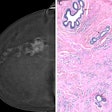| Adenocarcinoma: Nearly all breast cancers start in the ducts or lobules of the breast. Because this is glandular tissue, they are called adenocarcinomas, a term applied to cancers of glandular tissue anywhere in the body. The two main types of breast adenocarcinomas are ductal carcinomas and lobular carcinomas. | In situ: This term is used for the early stage of cancer, when it is confined to the immediate area where it began. Specifically in breast cancer, in situ means that the cancer remains confined to ducts (ductal carcinoma in situ) or lobules (lobular carcinoma in situ). It has not invaded surrounding fatty tissues in the breast nor spread to other organs in the body. |
| Ductal carcinoma in situ (DCIS): Ductal carcinoma in situ (also known as intraductal carcinoma) is the most common type of noninvasive breast cancer. DCIS means that the cancer cells are inside the ducts but have not spread through the walls of the ducts into the surrounding breast tissue. Approximately 20% of new breast cancer cases will be DCIS. Nearly all women diagnosed at this early stage of breast cancer can be cured. A mammogram is the best way to find DCIS early. When DCIS is diagnosed, an important distinction that will be considered by the pathologist is whether an area of dead or degenerating cancer cells, called tumor necrosis, is present. If necrosis is present, the tumor is considered more aggressive. The term comedocarcinoma is often used to describe DCIS with necrosis. | Lobular carcinoma in situ (LCIS): Although not a true cancer, LCIS (also called lobular neoplasia) is sometimes classified as a type of noninvasive breast cancer, and this is why it is included here. It begins in the milk-producing glands but does not penetrate through the wall of the lobules. Most breast cancer specialists think that LCIS itself does not usually become an invasive cancer, but women with this condition do have a higher risk of developing an invasive breast cancer in the same breast or in the opposite breast. For this reason, women with LCIS, in particular, should pay close attention to their screening for breast cancer. |
| Infiltrating (or invasive) ductal carcinoma (IDC): This is the most common breast cancer. It starts in a milk passage, or duct, of the breast. It is called invasive because it has broken through the wall of the duct, and invaded the fatty tissue of the breast. At this point, it can metastasize, or spread, to other parts of the body through the lymphatic system and bloodstream. About 80% of invasive breast cancers are infiltrating ductal carcinomas. | Infiltrating (or invasive) lobular carcinoma (ILC): This type of cancer starts in the milk-producing glands, or lobules. Similar to IDC, it also can spread (metastasize) to other parts of the body. About 5% of invasive breast cancers are ILCs. Invasive lobular carcinoma may be harder to detect by mammography than invasive ductal carcinoma. |
| Inflammatory breast cancer: This uncommon type of invasive breast cancer accounts for about 1% to 3% of all breast cancers. It makes the skin of the breast look red and feel warm, and gives the skin a thick, pitted appearance. Doctors now know that these changes are not caused by inflammation or infection, but by cancer cells blocking lymph vessels or channels in the skin. | Medullary carcinoma: This special type of infiltrating breast cancer has a rather well-defined, distinct boundary between tumor tissue and normal tissue. It also has some other special features, including the large size of the cancer cells and the presence of immune system cells at the edges of the tumor. Medullary carcinoma accounts for about 5% of breast cancers. The outlook, or prognosis, for this kind of breast cancer is better than for other types of invasive breast cancer. |
| Mucinous carcinoma: This rare type of invasive breast cancer is formed by mucus-producing cancer cells. The prognosis for mucinous carcinoma is better than for the more common types of invasive breast cancer. Colloid carcinoma is another name for this type of breast cancer. | Paget's disease of the nipple: This type of breast cancer starts in the breast ducts and spreads to the skin of the nipple and then to the areola, the dark circle around the nipple. It is rare, accounting for only 1% of all cases of breast cancer. The skin of the nipple and areola often appears crusted, scaly, and red, with areas of bleeding or oozing. The woman may notice burning or itching. Paget's disease may be associated with in situ carcinoma or with infiltrating breast carcinoma. If no lump can be felt in the breast tissue and the biopsy shows DCIS but no invasive cancer, the prognosis is excellent. |
| Phyllodes tumor: This very rare breast tumor develops in the stroma (connective tissue) of the breast, in contrast to carcinomas, which develop in the ducts or lobules. Phyllodes (also spelled phylloides) tumors are usually benign but on rare occasions may be malignant. Benign phyllodes tumors are treated by removing the mass and a narrow margin of normal breast tissue. A malignant phyllodes tumor is treated by removing it along with a wider margin of normal tissue, or by mastectomy. These cancers do not respond to the usual treatments for breast cancer. In the past, both benign and malignant phyllodes tumors were referred to as cystosarcoma phyllodes. | Tubular carcinoma: Tubular carcinomas are a special type of infiltrating breast carcinoma. They account for about 2% of all breast cancers and have a better prognosis than infiltrating ductal or lobular carcinomas. |



















